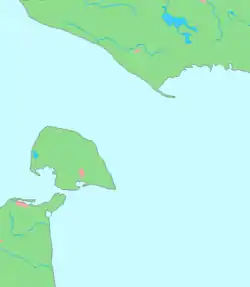Fehmarn Belt
Fehmarn Belt (![]() German pronunciation ), (Danish: Femern Bælt, former spelling Femer Bælt; Low German: Femernbelt) is a strait connecting the Bay of Kiel and the Bay of Mecklenburg in the western part of the Baltic Sea between the German island of Fehmarn and the Danish island of Lolland. Ferries operated by Scandlines connect Puttgarden and Rødby on the two islands.
German pronunciation ), (Danish: Femern Bælt, former spelling Femer Bælt; Low German: Femernbelt) is a strait connecting the Bay of Kiel and the Bay of Mecklenburg in the western part of the Baltic Sea between the German island of Fehmarn and the Danish island of Lolland. Ferries operated by Scandlines connect Puttgarden and Rødby on the two islands.
| Fehmarn Belt | |
|---|---|
 The Fehmarn Belt. The German island of Fehmarn is located to the south and the Danish island of Lolland to the north | |
 Fehmarn Belt | |
| Coordinates | 54°34′N 11°17′E |
| Type | strait |
| Basin countries | Germany Denmark |
| Max. length | 25 km (16 mi) |
| Min. width | 18.6 km (11.6 mi) |
| Max. depth | 30 m (98 ft) |

The strait features an 18-kilometre (10 nmi) wide area with depths of 20–30 metres. Currents in the strait are weak and mostly dependent on wind.
Swimming
It was initially swum across by Christof Wandratsch.[1]
Tunnel proposal
The Danish and German governments agreed on 29 June 2007 to build a fixed link to replace the ferry route. It is to save an hour on crossing the strait, and provide more crossing capacity.
In 2011, the Danish parliament voted overwhelmingly (with seven of eight parties supporting) for the €5.1 billion project that is intended to open in 2020.[2] The tunnel is to have three separate bores, two containing two motorway lanes each, and one with a double-track railway line.[2]
Famous shipwrecks
- 13 October 1644 The Danish men-of-war Delmenhorst, Lindormen and the Dutch Swarte Arendt was sunk during the Battle of Fehmarn (1644)
- 21 July 1932 The German school ship Niobe capsized during a white squall
References
- "Dänemark baut Supertunnel nach Deutschland". Der Spiegel, online edition (in German). 1 February 2011. Retrieved 1 February 2011.
